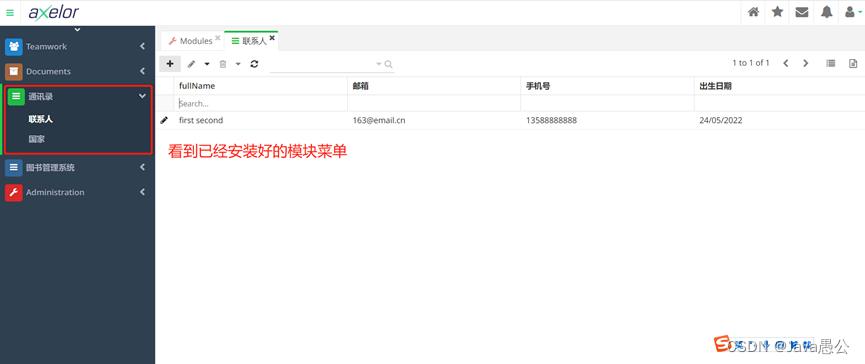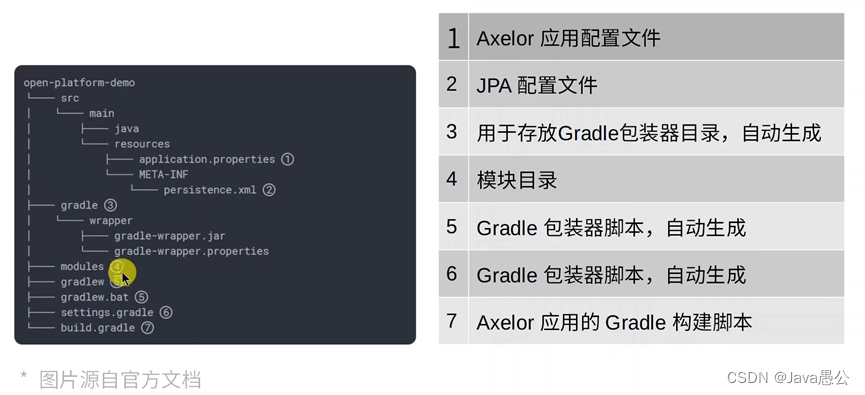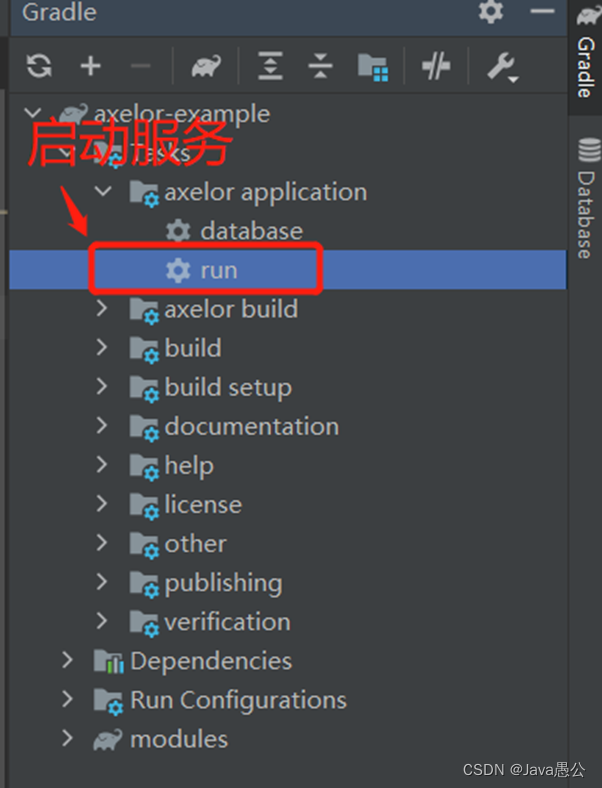目录结构介绍
目录结构介绍可参考Axelor官网给的说明,参考地址:https://docs.axelor.com/adk/5.0/tutorial/step1.html
配置文件介绍
配置图文说明如下:
搭建子模块
搭建子模块参考官网地址:https://docs.axelor.com/adk/5.0/tutorial/step1.html
第1步:创建项目
参考地址:https://docs.axelor.com/adk/5.0/tutorial/step1.html
注意:基于我们前面已经创建gradle的项目,请翻阅我上文写的如何搭建axelor的文章。
第2步:创建模块
参考地址:https://docs.axelor.com/adk/5.0/tutorial/step2.html
在应用程序项目中创建一个新目录modules/contact并创建模块构建脚本
modules/contact/build.gradleapply plugin: 'com.axelor.app-module' axelor { title "Contact Address System" version "2.2.1" description "This is a contact address system. yoyoyo ~~ " removable = true } dependencies { }
将模块包含到settings.gradle应用程序项目中。
settings.gradlerootProject.name = 'axelor-example' include "modules:contact"
并且应用程序正在使用这个模块,所以build.gradle必须像这样更新
build.gradle…省略前面部分 dependencies { compile project(":modules:contact") } …省略后面部分
现在检查项目是否配置正确,再次构建它
$ ./gradlew build
第3步:定义模型
参考地址:https://docs.axelor.com/adk/5.0/tutorial/step3.html
在contact/src/main/resources/domains/Title.xml 新建Title.xml文件
<?xml version="1.0" encoding="UTF-8"?>
<domain-models xmlns="http://axelor.com/xml/ns/domain-models"
xmlns:xsi="http://www.w3.org/2001/XMLSchema-instance"
xsi:schemaLocation="http://axelor.com/xml/ns/domain-models
http://axelor.com/xml/ns/domain-models/domain-models_5.4.xsd">
<module name="contact" package="com.example.contact.db"/>
<entity name="Title" table="TITLE" repository="default" sequential="false">
<string name="code" required="true" unique="true" min="2" title="标题编码"/>
<string name="name" required="true" unique="true" min="2" namecolumn="true" title="标题名称"/>
</entity>
</domain-models>
在contact/src/main/resources/domains/Address.xml 新建Address.xml文件
<?xml version="1.0" encoding="UTF-8"?>
<domain-models xmlns="http://axelor.com/xml/ns/domain-models"
xmlns:xsi="http://www.w3.org/2001/XMLSchema-instance"
xsi:schemaLocation="http://axelor.com/xml/ns/domain-models
http://axelor.com/xml/ns/domain-models/domain-models_5.4.xsd">
<module name="contact" package="com.example.contact.db"/>
<entity name="Address" table="ADDRESS" repository="default" sequential="false">
<many-to-one name="contact" ref="Contact" required="true"/>
<string name="street" required="true" max="255" title="街道"/>
<string name="area" max="255" title="区域"/>
<string name="city" title="城市"/>
<string name="zip" title="zip"/>
<string name="state" title="state"/>
<string name="country" title="国家"/>
</entity>
</domain-models>
在contact/src/main/resources/domains/Contact.xml 新建Contact.xml文件
<?xml version="1.0" encoding="UTF-8"?>
<domain-models xmlns="http://axelor.com/xml/ns/domain-models"
xmlns:xsi="http://www.w3.org/2001/XMLSchema-instance"
xsi:schemaLocation="http://axelor.com/xml/ns/domain-models
http://axelor.com/xml/ns/domain-models/domain-models_5.4.xsd">
<module name="contact" package="com.example.contact.db"/>
<entity name="Contact" table="CONTACT" repository="default" sequential="false">
<many-to-one name="title" ref="Title" title="标题"/>
<string name="firstName" required="true" title="firstName"/>
<string name="lastName" required="true" title="lastName"/>
<string name="fullName" namecolumn="true" search="firstName,lastName" title="fullName">
<![CDATA[
if (firstName == null && lastName == null) {
return null;
}
if (title == null) {
return firstName + " " + lastName;
}
return title.getName() + " " + firstName + " " + lastName;
]]>
</string>
<date name="dateOfBirth" title="出生日期"/>
<string name="email" required="true" unique="true" max="100" title="邮箱"/>
<string name="phone" max="20" massUpdate="true" title="手机号"/>
<string name="notes" large="true" title="备注"/>
<one-to-many name="addresses" ref="Address" mappedBy="contact" title="地址"/>
<finder-method name="findByName" using="fullName"/>
<finder-method name="findByEmail" using="email"/>
</entity>
</domain-models>
第4步:定义视图
参考地址:https://docs.axelor.com/adk/5.0/tutorial/step4.html
在contact/src/main/resources/views/Contact.xml 新建Contact.xml文件
<?xml version="1.0" encoding="UTF-8" standalone="yes"?>
<object-views xmlns="http://axelor.com/xml/ns/object-views"
xmlns:xsi="http://www.w3.org/2001/XMLSchema-instance"
xsi:schemaLocation="http://axelor.com/xml/ns/object-views
http://axelor.com/xml/ns/object-views/object-views_5.4.xsd">
<grid name="contact-grid" title="通讯录列表" model="com.example.contact.db.Contact">
<field name="fullName"/>
<field name="email"/>
<field name="phone"/>
<field name="dateOfBirth"/>
</grid>
<form name="contact-form" title="通讯录表单" model="com.example.contact.db.Contact">
<panel name="overviewPanel" title="概述">
<field name="fullName" readonly="false">
<editor>
<field name="title" colSpan="3"/>
<field name="firstName" colSpan="4"/>
<field name="lastName" colSpan="5"/>
</editor>
</field>
<field name="dateOfBirth"/>
<field name="email">
<viewer>
<![CDATA[
<a href="mailto:{{record.email}}">{{record.email}}</a>
]]>
</viewer>
</field>
<field name="phone">
<viewer>
<![CDATA[
<a href="tel:{{record.phone}}">{{record.phone}}</a>
]]>
</viewer>
</field>
</panel>
<panel name="aboutMePanel" title="备注">
<field name="notes" showTitle="false" colSpan="12"/>
</panel>
<panel-related field="addresses" name="addressesPanel" form-view="address-form-popup">
<field name="street"/>
<field name="area"/>
<field name="city"/>
<field name="state"/>
<field name="zip"/>
<field name="country"/>
</panel-related>
<panel name="sidePanel" sidebar="true" stacked="true">
<field name="createdOn"/>
<field name="createdBy"/>
<field name="updatedOn"/>
<field name="updatedBy"/>
</panel>
</form>
<form name="address-form-popup" title="Address" model="com.example.contact.db.Address">
<panel title="概述">
<field name="street"/>
<field name="area"/>
<field name="city"/>
<field name="zip"/>
<field name="state"/>
<field name="country"/>
</panel>
</form>
</object-views>
第5步:定义操作
参考地址:https://docs.axelor.com/adk/5.0/tutorial/step5.html
在contact/src/main/resources/views/Menu.xml 新建Menu.xml文件
<?xml version="1.0" encoding="UTF-8" standalone="yes"?>
<object-views xmlns="http://axelor.com/xml/ns/object-views"
xmlns:xsi="http://www.w3.org/2001/XMLSchema-instance"
xsi:schemaLocation="http://axelor.com/xml/ns/object-views
http://axelor.com/xml/ns/object-views/object-views_5.4.xsd">
<menuitem name="menu-contact-menu" title="通讯录"/>
<!-- 联系人 -->
<menuitem name="menu-contact"
parent="menu-contact-menu"
title="联系人"
action="contact.all"/>
<action-view name="contact.all"
title="联系人"
model="com.example.contact.db.Contact">
<view type="grid" name="contact-grid"/>
<view type="form" name="contact-form"/>
</action-view>
</object-views>
第6步:配置
参考地址:https://docs.axelor.com/adk/5.0/tutorial/step6.html
在src/main/resources/application.properties 设置数据库配置
src/main/resources/application.properties
# Database settings
# ~~~~~
db.default.driver = org.postgresql.Driver
db.default.ddl = update
db.default.url = jdbc:postgresql://localhost:5432/axelor-demo
db.default.user = user
db.default.password = secret
第7步:启动服务器
参考地址:https://docs.axelor.com/adk/5.0/tutorial/step7.html
可以在Gradle功能菜单栏中
Task --> axelor appplication中点击run
启动成功界面如下:
启动成功后会在控制台输出得到 Running at http://localhost:8080/axelor-example
在浏览器访问 http://localhost:8080/axelor-example
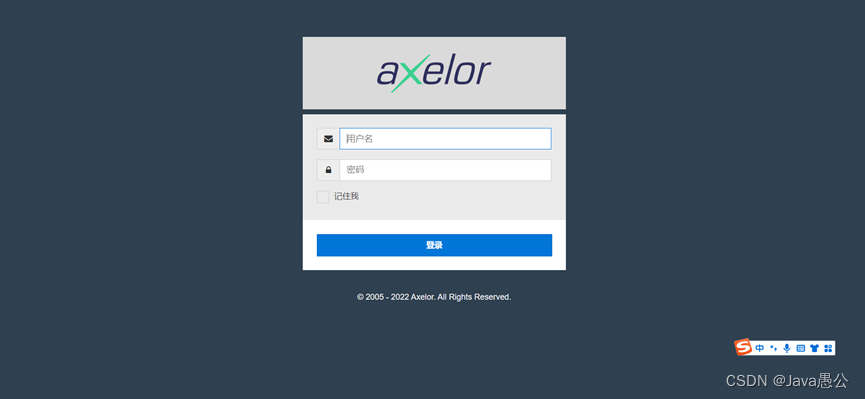
项目初始化的时候会默认新建两个用户,对应的数据库表(auth_user),可自己查看;
用户1:用户名:admin 密码:admin
用户2:用户名:demo 密码:demo
我们输入admin用户访问系统;
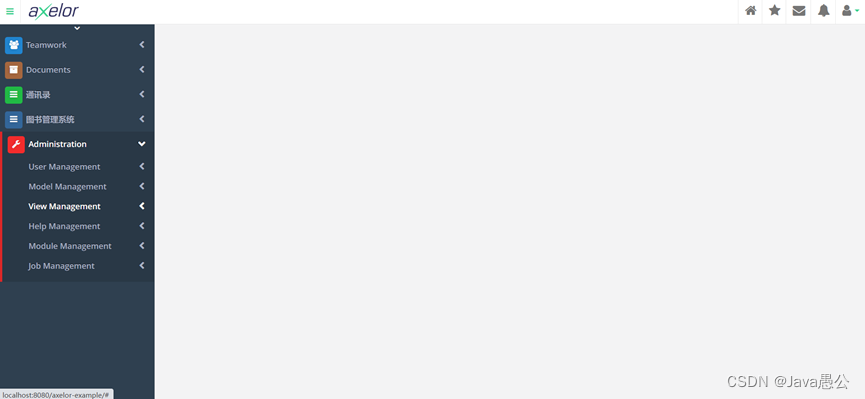
安装子模块
在Administration –-> Module Management --> All Modules中,
点击要安装的模块的Pending列的按钮,比如我这里要安装的是‘contact’模块,点击及安装;

使用子模块
安装模块成功之后会在系统菜单栏看到新增加的模块菜单,比如我刚才安装的是‘contact’模块,这里能看到 ‘通讯录’ 的菜单栏,
